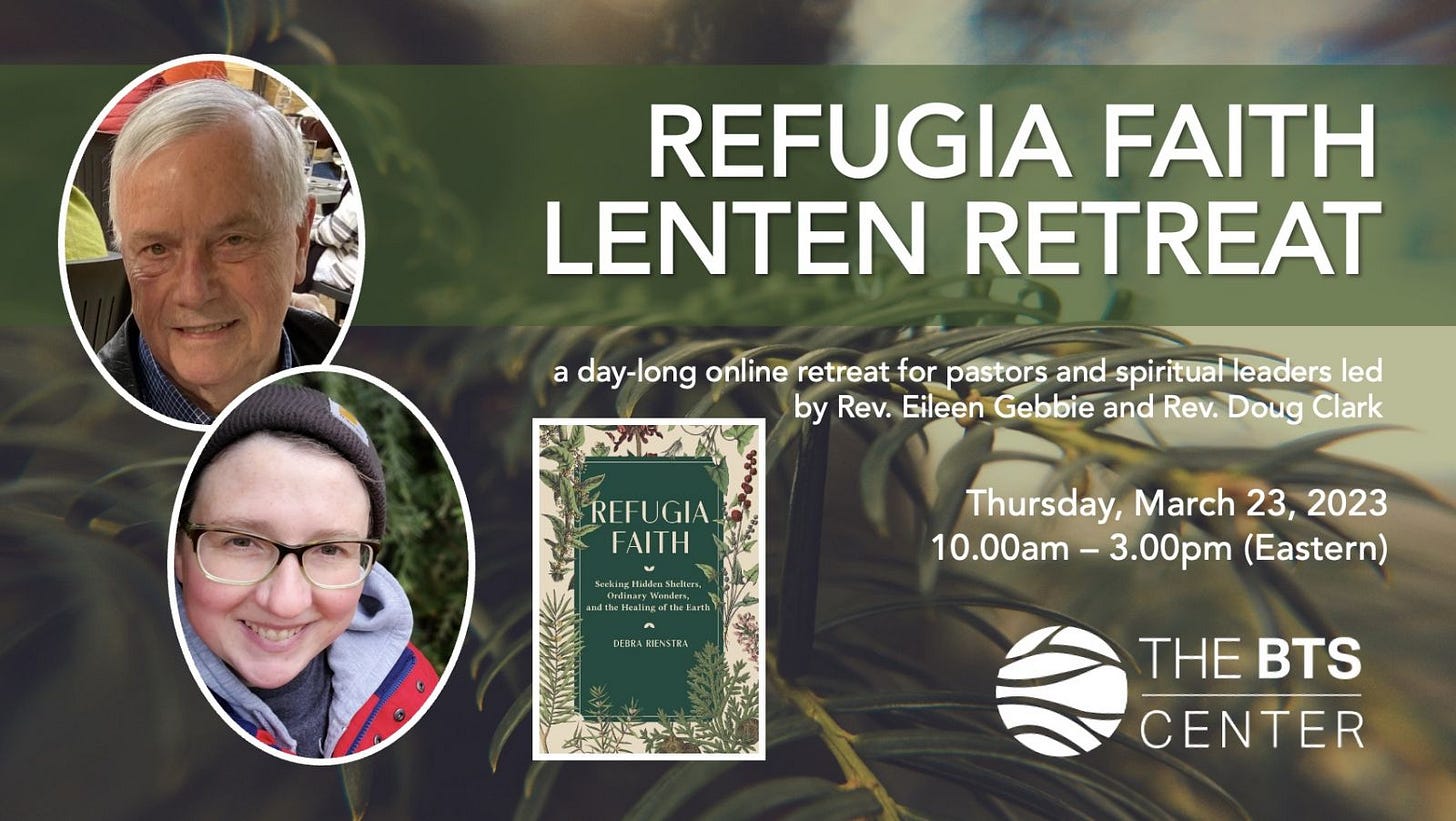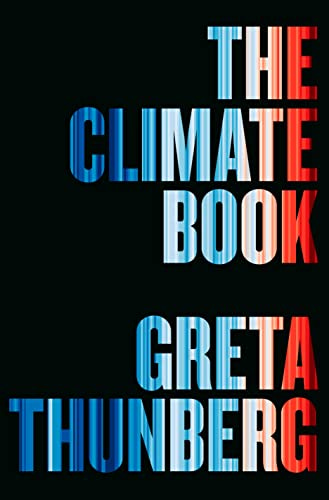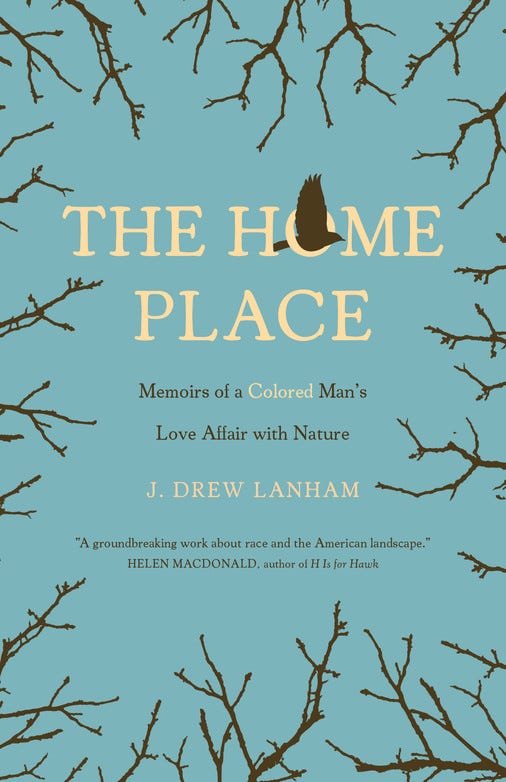Refugia Newsletter #35
A celebration of climate books, a look at that 1.5 degree goal, and some Lenten thoughts about mortality.
Refugia News
Happy birthday to Refugia Faith, which is one year old as of February 22! To celebrate, we’re going to emphasize other books today—because one of the best things about being a book author is entering a larger conversation, one carried on by many wonderful people (and their books).
But first, I want to share with you the recording of the lovely BTS event from February 16. The event featured music by the excellent Pax Ressler, a conversation between BTS Executive Director Allen Ewing-Merrill and me, and then a panel featuring impressive, young (well, younger than me!) Christian climate leaders Jenna VanDonselaar, William Morris, and Ben Yosua-Davis.
The center is planning a Lenten Retreat in March connected to Refugia Faith. You can learn more here.
This coming week, I’m off on a different kind of adventure: a pilgrimage to the South with a group of folks gathered by the Calvin Institute of Christian Worship. I’m enormously grateful for this privilege. We’re visiting New Orleans, Selma, the Edmund Pettis Bridge, and other key sites in American history to reflect together on racism and injustice. While engaging with the workshops and visits and conversations, I also want to keep a particular eye out for instances of environmental injustice, both historic and current—and I promise to report back next time.
This Week in Climate News
Two quick stories before we get to books.
First, the train derailment in East Palestine, Ohio, continues to prompt analysis of all the lousy shenanigans that led to it, exposing yet again the power of the fossil fuel industry lobby. Writers for Politico noted that the groundwork for the accident was laid in the previous presidential administration’s reckless bowing to industry lobbying:
Trump’s administration withdrew an Obama-era proposal to require faster brakes on trains carrying highly flammable materials, ended regular rail safety audits of railroads, and mothballed a pending rule requiring freight trains to have at least two crew members. He also placed a veteran of the chemical industry in charge of the Environmental Protection Agency’s chemical safety office, where she made industry-friendly changes to how the agency studied health risks.
Writers for Grist succinctly point out that this is a plastics story and thus a fossil fuel industry story. Inside Climate News explains the dangers of the particular plastics involved in more detail. The EPA has directed Norfolk Southern to pay the costs for clean up and damage, but we are looking at long-term effects that cannot easily be tidied, as described in this article in the New York Times by Emily Cochrane about people who are now worried that their land and water will be poisoned for a long time, despite reassurances.
The other story is good news: David Malpass, the climate-denier president of the World Bank, has resigned. This spared President Biden having to call for his ouster—a dicey proposition—and now gives President Biden a huge opportunity. Here’s what David Gelles wrote in the New York Times:
Malpass, who has been roundly vilified by climate activists, has given the Biden administration a gift of sorts. Mr. Biden came to office with big ambitions to address climate change and has already signed into law the country’s first major climate legislation. Now, thanks to Malpass, Mr. Biden has the chance to install a climate-focused leader who can influence the pivotal work set to unfold over the next year, in all likelihood leaving the administration’s imprint on the bank for many decades to come. [bold added]
Now time for book news!
I received my copy of Greta Thunberg’s new book this week, aptly titled The Climate Book. It’s an ambitious primer. If you’re the sort of reader who likes to go big or go home, this book is for you (440 pages!). Thunberg has gathered all the big players in the climate movement and had them contribute small chapters under five big headings: How Climate Works, How Our Planet is Changing, How It Affects Us, What We’ve Done About It, and What We Must Do Now. I’m just getting started on this one—I’m planning to take it along on my trip next week and work my way through it.
Meanwhile, for Black History Month, the good people at Yale Climate Connections have put together a list of climate and environmental justice titles, most of them by Black authors. I’m going to keep this list handy as I create my summer reading list. Oh, who am I kidding? I already have a huge summer reading list. Oh well. In February, everything seems possible for the summer ahead.
I recently finished a lovely book by the nature writer J. Drew Lanham. I would describe it as a “place memoir.” Lanham writes engagingly about growing up on family land in South Carolina, what it means to cherish land, what it means to lose it.
Deeper Dive
In my ongoing efforts to somehow manage the ginormous supply of climate topics, I’ll focus this time on another “how are we doing” question. This time, the question is How are we doing on that 1.5 degrees goal?
This is the familiar goal, affirmed in 2015 as part of the Paris Agreement, that we have to keep average global temperatures from warming any more than 1.5 degrees Celsius over pre-industrial levels. Well, as you can guess, that goal is getting more and more elusive. We have already reached 1.1 degrees of warming.
I am always a sucker for good data-viz, so I present to you this article from The Washington Post from this past December. The authors are Chris Mooney, Naema Ahmed, and John Muyskens. And I’m especially pleased to tell you that John is a Calvin University grad and a family friend—as well as being a Pulitzer-Prize winning data-viz-wizard. (Go John!)
The article compiles research, in cooperation with the Potsdam Institute, to examine 1200 “paths” or scenarios. What we want to do is keep to that 1.5 degree goal but also avoid “overshoot”—that is, hitting a higher level of warming before cooling back down by 2100. We also have to consider which scenarios are “reasonable,” “challenging,” and “speculative” (i.e., probably not going to happen or based on tech we don’t really have).
The problem is that when you narrow things down to “low overshoot” and “reasonable,” you run out of paths:
What the results suggest is that the world has probably run out of easy options to stay under 1.5C — or have a low overshoot.
Check out this gorgeous image showing the 112 “hopeful” paths:
image credit: Washington Post
Note the number of paths that involve high overshoot. Overshoot is especially worrisome because we just don’t know what temps that high could mean for feedback loops and compounding effects. This piece by Bob Berwyn of Inside Climate News explains in chilling detail what we could be looking at.
It’s true, as Emma Marris points out in The Atlantic, that 1.5 degrees does not represent the edge of a cliff, at least not that we know of. Every tenth of a degree makes a difference either way.
Still, as the Post article concludes, the data is sobering and we need to redouble efforts:
At the U.N. Climate Change Conference late last month, world leaders reaffirmed the 1.5C goal. But these scenarios show that without dramatic action — action the leaders did not commit to taking — it most likely will not be possible.
Or at least, not without a major overshoot first. That is where the world is currently heading.
Refugia Sighting
For our sighting today, I’ll continue with my new mini-interview feature. I’m delighted to announce that my friend Kyle Meyaard-Schaap released a book this week: Following Jesus in a Warming World: A Christian Call to Climate Action (Intervarsity). I’m such a fan of this book. I got to blurb it! Here’s part of what I wrote: “This book is a deeply scriptural call to advocacy for people and planet as both moral necessity and spiritual discipline.” I think of this book as the perfect thing for your Christian friend/relative/colleague who kinda-sorta wants to do something about climate, but hesitates for whatever reason. Hand this book to them and say: “Here. Read this.”
Thanks to Kyle for agreeing to have a quick chat with me!
Many Christians who are worried about climate change feel as if they are walking “a lonely journey,” as you put it. What do you mean by that phrase? Where can they find companionship?
Whether implicitly or explicitly, many of us have received the message that the church is no place for talk as crass and political as "'climate change". Best to leave that to the Sierra Club rally across town. The irony, as I explore in my book, is that the data show that way more people in our church than we think share our climate concerns. We just don't know it because none of us are talking about it. When we start rejecting the notion that climate change doesn't belong in the church and we start talking about it, we find a lot more support and solidarity than we might expect.
What is the “big story” of Christianity that we need to recover right now?
Too often, we think of the more-than-human creation as merely the backdrop for God's unfolding drama of salvation, when in fact, the whole of creation itself is an active participant in the unfolding story. It extends God's grace to us in bread, wine, and water. Like us, it too is being reconciled back to God through Christ (Col. 1:20). And it has an eternal destiny in God's coming good future (Rev. 21:1-5). The nonhuman creation is so much more than mere window dressing in service of the main characters in the story of salvation. It is a main player itself!
One of your chapters is called “Loving our neighbors in public.” Where does that phrase come from and what does it mean?
I think I made it up, but it's influenced by people like Jim Wallis, Ron Sider, Mitch Hescox, Shane Claiborne, and Tony Campolo who have been calling the church for decades to stop privatizing and spiritualizing their faith and to recognize the public dimensions of discipleship. In a hyperconnected world, where every choice we make has ripple effects half a world away, Christians must bring the peace and justice of Jesus into the public square for the sake of the common good. Engaging in public advocacy, shaping policy, and expressing the love of Christ in civic spaces are all acts of public neighbor love, and they are all the more urgent and necessary as we try to follow Jesus more closely in a warming world.
The Wayback Machine
Now that the season of Lent has officially arrived, I offer this piece I wrote in 2017 after serving as a musician at a funeral for a beloved elder in my church. I was surprised, reading it again, how all these feelings came right back to me—the gratitude, the sadness, the reflections on our ephemeral place in this bright world. This piece about remembering our mortality.
We musicians have packed up our instruments, gathered our coats. “See you on Sunday,” we say to each other. We disperse to our various Friday nights, to the present moments, the varied textures of lives still in progress.
Till next time, be well.









So grateful for this letter, Debra. You keep things moving--which in a rapidly changing world is super helpful--but the recommendations are substantial. I want to read these books.
Wes and I really appreciated your thoughts on mortality after playing at a funeral. As 90 and 76 respectively, it stimulated a very intimate and thought provoking discussion on our own death and dying. Wes commented it was a relief to be reminded how soon we may be forgotten. Thank you.